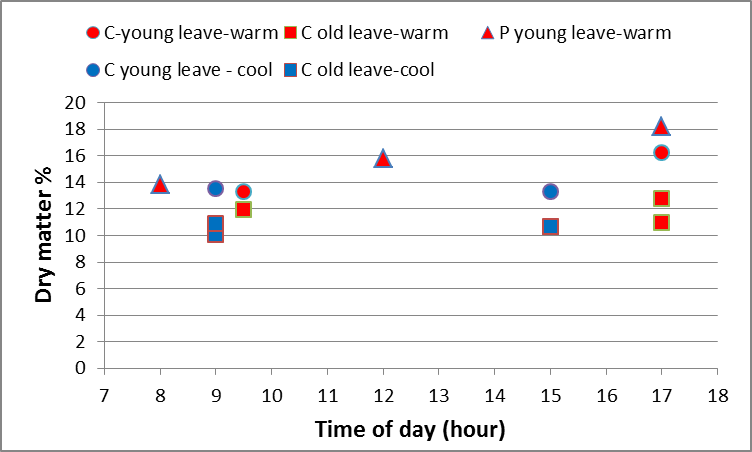Solar radiation can influence plantsap
9 June 2020 - Articles
The amount of solar radiation affects the results of the PlantsapCheck and CropCheck analyses, according to a recent trial at two nurseries in the Netherlands. The results show that the composition of the plant sap and dry matter can vary greatly during the course of the day, depending on the greenhouse climate Therefore, always make sure you take samples in similar conditions.
The question of how many nutrients a crop has taken up is important for optimising fertilisation. PlantsapCheck is an analysis of nutrients in plant sap, and CropCheck analyses nutrients in dry matter.
Water uptake
Water plays an important role in many plant processes. As the plant takes up water, it also takes in nutrients. This process is greatly influenced by the greenhouse climate. Two mechanisms control water uptake and nutrient transport in the plant:
- root pressure
- transpiration
The stomata in the leaves control the rate of transpiration through the leaves. More on transpiration and stomata >
Practical trial
On warm, sunny days such as there were many in the Netherlands in April 2020, the dry matter content and the composition of the plant sap are expected to change during the course of the day, as water uptake lags slightly behind transpiration.
To test this hypothesis, Eurofins Agro conducted an experiment in collaboration with two growers. On a cool day with little solar radiation and on a warm day with high levels of solar radiation, leaf samples were taken for plant sap and dry matter analyses at different times of the day. The climate data of the various days is shown in table 1.
Table 1: Climate data on the various days in Dutch Greenhouses. Eurofins Argo 2020
|
Date |
23 April 2019 |
28 April 2020 |
6 May 2020 |
|
Crop |
Sweet pepper (P) |
Cucumber (C) |
Cucumber (C) |
|
Description of weather |
warm |
cool |
cool |
|
Ave. greenhouse temp. (oC)1 |
22 |
21 |
24 |
|
Ave. outdoor temp. (oC)1 |
17 |
10 |
14 |
|
Ave. outdoor temp. (oC)2 |
16 |
11 |
12 |
|
Max. temperature (oC)2 |
22 |
12 |
17 |
|
Time (hours)2 |
15:00 |
18:00 |
18:00 |
|
Ave. RH% in greenhouse1 |
87 |
70 |
|
|
Approx. radiation (W/m2) 1 |
208 |
89 |
589 |
1) source: grower’s climate system
2) source: KNMI climate data per hour
Dry matter content
The dry matter measurements show that in both the cucumber and the sweet pepper crop, the dry matter in the leaves increases during the course of the day on warm days with high solar radiation (see figure 1). The water in the plant decreases. However, the extent of the difference depends on the crop and the leaves.

Figure 1: Changes in dry matter content during the day in young sweet pepper leaves (P) and old and young cucumber leaves (C) on a cool day (April 28, 2020) and a warm day (April 23, 2019 and May 6, 2020). Source: Eurofins Agro
The dry matter content of young leaves of sweet pepper and cucumber plants increases by 30% and 20% respectively during the course of a warm day. However, the older leaves of cucumber plants show no difference in dry matter between the warm and cold days. Older leaves are less active and are lower down the plant, so they are less affected by higher or lower levels of solar radiation.
Nutrients
A change in the nutrient composition in the plant sap during the course of the day can also be observed. For example, the plant sap concentration of magnesium (Mg) and calcium (Ca) in both old and young cucumber leaves changes during the course of the day. This can be explained by the fact that Ca in a plant is very immobile, whilst Mg is partly mobile. So, the amounts measured in the plant sap will have been taken up recently by the plant. This is unlike the mobile nutrients potassium (K) and nitrate (NO3), for example, which are translocated while the plant is growing and developing.
The reduction in Ca and Mg concentrations in plant sap in young cucumber leaves is greater during a warm day (30% and 20% respectively) than on a cooler day (24% and 5% respectively). Ca and Mg are absorbed simultaneously with water; if water uptake is lower, then less of these minerals will be taken up. Water uptake is lower on a warm day, when the stomata are partially closed, so nutrient uptake will also be lower.
Conclusion
When carrying out regular sampling (weekly or fortnightly), it is important to always sample the crop at the same time of day to ensure accurate monitoring of the crop composition. The ideal time for the PlantsapCheck and the CropCheck is early in the morning, as the crop’s transpiration rate has not yet reached its peak and the water taken up ensures the plant is sufficiently turgid. This way, differences between the weekly or fortnightly measurements can be ascribed to differences in nutrient uptake rather than in dry matter content.
More information
Please contact horti@eurofins.com
